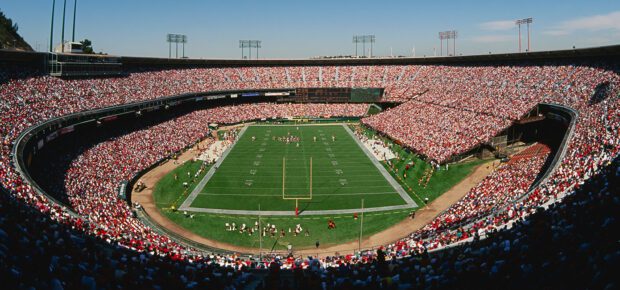January 25, 2022
Stadiums around the world allow seating capacities that rival small cities. Those crowds can get even bigger when it comes to big games and major championships. When these larger venues are filled to capacity, it can bring a whole new level of infrastructure demand. Their size presents challenges that mirror the predicted challenges of our increasingly urbanized world: lots of vehicular traffic, huge network demands and public safety concerns.
There’s a growing body of research that argues that these venues provide a laboratory for smart cities technology.
Traffic Congestion
Large crowds arrive and leave major sporting events at the same time, creating huge traffic jams. Sometimes, navigation apps may even divert people to side streets, creating ancillary jams in residential areas.
“AI can be used to optimize the travel experience to and from the stadium so that you don’t have to wait for hours in your car,” said IEEE Member Bilin Aksun-Guvenc. “Your parking space can also be reserved and your vehicle can be parked autonomously.”
Energy Efficiency and Consumption
Sports stadiums use massive amounts of energy, during game time and downtime. There’s significant interest in using IoT sensors to manage lighting and power consumption in stadiums, by, for example, dimming the lights in empty portions of stadiums, and automatically brightening them for storms or to signal to staff of imminent emergencies.
But big games like football championships and a World Cup Match can have significant impacts well outside the stadium. The transition to half-time, when people get up to make food or wash dishes, can lead to large frequency fluctuations in power grids that must be managed.
Network Capacity
Live, in-person sports have a major competitor: It’s easy, and comfortable, to watch events at home. So stadium operators are investing in features to improve the fan experience. Augmented reality is often seen as a solution. Some stadiums have experimented with AR “bobbleheads.” Another proposed system would turn a smartphone into a window through which to watch the game. When the phone’s camera spots a player, the system would tag the player in the display and also offer enhanced stats.
These features add to the already enormous demands from simply hosting tens of thousands of people in a single location.
IEEE Life Senior Member Raul Colcher said that the Internet of Things-based contribute to demands – including services that monitor the movement of people to and from exits, guide them to seats, and facial recognition apps to manage payments.
“For all this to be possible with a high concentration of people, new telecommunications resources, in public and proprietary networks, must be made available,” Colcher said. “Naturally, this poses new challenges regarding the massive availability of broadband access in confined environments.”
Smart cities infrastructure is critical to the operation of live sporting events, and that role will only grow. If you want a glimpse of how smart cities technology and smart infrastructure might be deployed, look no further than your local stadium.
If you’d like to learn more about how integrated and open IoT systems could help manage transportation to and from stadiums at FIFA 2022 In Qatar, check out this paper from IEEE Access.





 Meaningful Momentum or Running in Place?
Meaningful Momentum or Running in Place? AI Through Our Ages
AI Through Our Ages Liquid Infrastructure: Our Planet's Most Precious Resource
Liquid Infrastructure: Our Planet's Most Precious Resource The Impact of Technology in 2025
The Impact of Technology in 2025 Quantum and AI: Safeguards or Threats to Cybersecurity?
Quantum and AI: Safeguards or Threats to Cybersecurity? Why AI Can't Live Without Us
Why AI Can't Live Without Us Bits, Bytes, Buildings and Bridges: Digital-Driven Infrastructure
Bits, Bytes, Buildings and Bridges: Digital-Driven Infrastructure Impact of Technology in 2024
Impact of Technology in 2024 Emerging AI Cybersecurity Challenges and Solutions
Emerging AI Cybersecurity Challenges and Solutions The Skies are Unlimited
The Skies are Unlimited Smart Cities 2030: How Tech is Reshaping Urbanscapes
Smart Cities 2030: How Tech is Reshaping Urbanscapes Impact of Technology 2023
Impact of Technology 2023 Cybersecurity for Life-Changing Innovations
Cybersecurity for Life-Changing Innovations Smarter Wearables Healthier Life
Smarter Wearables Healthier Life Infrastructure In Motion
Infrastructure In Motion The Impact of Tech in 2022 and Beyond
The Impact of Tech in 2022 and Beyond Cybersecurity, Technology and Protecting Our World
Cybersecurity, Technology and Protecting Our World How Technology Helps us Understand Our Health and Wellness
How Technology Helps us Understand Our Health and Wellness The Resilience of Humanity
The Resilience of Humanity Harnessing and Sustaining our Natural Resources
Harnessing and Sustaining our Natural Resources Creating Healthy Spaces Through Technology
Creating Healthy Spaces Through Technology Exceptional Infrastructure Challenges, Technology and Humanity
Exceptional Infrastructure Challenges, Technology and Humanity The Global Impact of IEEE's 802 Standards
The Global Impact of IEEE's 802 Standards Scenes of our Cyber Lives: The Security Threats and Technology Solutions Protecting Us
Scenes of our Cyber Lives: The Security Threats and Technology Solutions Protecting Us How Millennial Parents are Embracing Health and Wellness Technologies for Their Generation Alpha Kids
How Millennial Parents are Embracing Health and Wellness Technologies for Their Generation Alpha Kids Space Exploration, Technology and Our Lives
Space Exploration, Technology and Our Lives Global Innovation and the Environment
Global Innovation and the Environment How Technology, Privacy and Security are Changing Each Other (And Us)
How Technology, Privacy and Security are Changing Each Other (And Us) Find us in booth 31506, LVCC South Hall 3 and experience the Technology Moon Walk
Find us in booth 31506, LVCC South Hall 3 and experience the Technology Moon Walk Virtual and Mixed Reality
Virtual and Mixed Reality How Robots are Improving our Health
How Robots are Improving our Health IEEE Experts and the Robots They are Teaching
IEEE Experts and the Robots They are Teaching See how millennial parents around the world see AI impacting the lives of their tech-infused offspring
See how millennial parents around the world see AI impacting the lives of their tech-infused offspring Take the journey from farm to table and learn how IoT will help us reach the rising demand for food production
Take the journey from farm to table and learn how IoT will help us reach the rising demand for food production Watch technical experts discuss the latest cyber threats
Watch technical experts discuss the latest cyber threats Explore how researchers, teachers, explorers, healthcare and medical professionals use immersive technologies
Explore how researchers, teachers, explorers, healthcare and medical professionals use immersive technologies Follow the timeline to see how Generation AI will be impacted by technology
Follow the timeline to see how Generation AI will be impacted by technology Learn how your IoT data can be used by experiencing a day in a connected life
Learn how your IoT data can be used by experiencing a day in a connected life Listen to technical experts discuss the biggest security threats today
Listen to technical experts discuss the biggest security threats today See how tech has influenced and evolved with the Games
See how tech has influenced and evolved with the Games Enter our virtual home to explore the IoT (Internet of Things) technologies
Enter our virtual home to explore the IoT (Internet of Things) technologies Explore an interactive map showcasing exciting innovations in robotics
Explore an interactive map showcasing exciting innovations in robotics Interactively explore A.I. in recent Hollywood movies
Interactively explore A.I. in recent Hollywood movies Get immersed in technologies that will improve patients' lives
Get immersed in technologies that will improve patients' lives